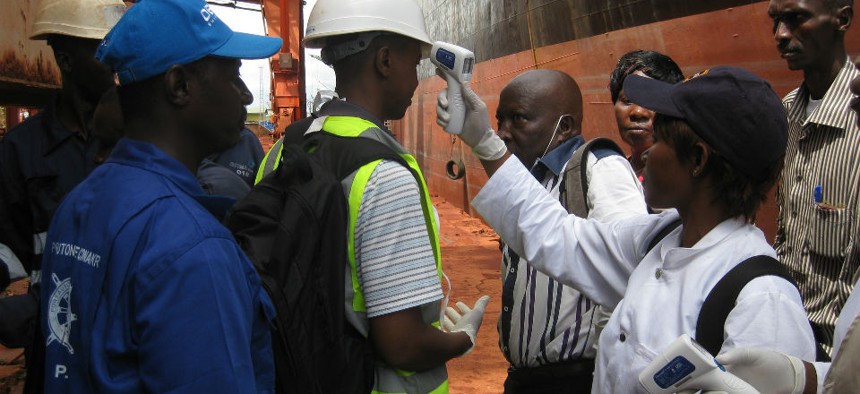
A team from CDC observes health screening at the Conakry Maritime Port in Guinea. Emily Jentes/Centers for Disease Control and Prevention
CDC Officials Own Up to Missing Ebola Signals
The virus had infected 20,000 people in West Africa and claimed the lives of nearly 8,000 as of December 2014.
Both the director and the top Ebola expert at the Centers for Disease Control and Prevention acknowledged regrets about decisions made as the virus lulled and then spread last spring, according to a lengthy analysis published Monday in The New York Times.
Dr. Pierre Rollin, the CDC Ebola specialist who spent five and a half weeks in Guinea during the early days of the outbreak, at that time noted that the number of new cases had slowed to a trickle, prompting some aid organizations to withdraw. “This is close to over,” he told himself on a May flight back to Atlanta. “That’s it for this outbreak.”
Instead, the Times reported, his work was just beginning as Ebola would go on to attack 20,000 people and cause 7,800 deaths as of December.
Rollin now says he accepts a share of the responsibility for underestimating the virus, and that health officials should have recognized the role West African cultural practices and attitudes regarding such issues as burial would play in its spread. “It was an unprecedented outbreak,” he said. “There were a lot of things we didn’t know at that time.”
CDC Director Dr. Tom Frieden told the Times, “Sure, in hindsight I wish we’d had more staff on the ground. I don’t think any of our organizations would look back and say we did everything right.”
In early December, the emergency room physician at Texas Health Presbyterian Hospital who treated the man who became the first Ebola fatality in the United States, also acknowledged error, according to the Dallas Morning News. “I was unaware of a 103-degree fever,” one Ebola symptom, the doctor, Joseph Howard Meier, wrote in answer to questions from the newspaper. “It appears in the chart, but I did not see it.”
NEXT STORY: A Roadmap of Business Manners Coast to Coast







